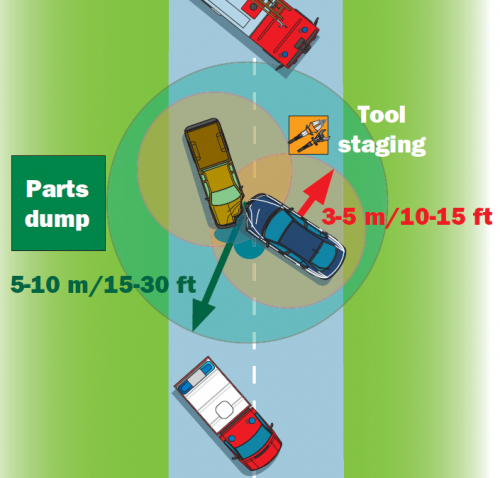The Team Approach - Safety and Scene Assessment
The Team Approach - Safety and Scene Assessment
Safety is the priority for any rescuer and this must be the case for the full duration of the rescue. Whilst safety is everybody’s responsibility, the officer in charge (OIC) must complete an initial assessment of the scene. During this assessment the OIC must identify and communicate the hazards on scene and where possible instruct crews to control these hazards before any work can commence. Another reason for the initial assessment is to locate and identify casualties. These can be in the vehicles involved or indeed they can be located anywhere on scene. For this reason it is good practice for the medic to accompany the OIC during this initial assessment so the appropriate medical assistance can be deployed following this triage.
The assessment should be a 360 survey of the scene and during this time, crews can start to prepare equipment, but not start the rescue process.
Only once the scene has been assessed, hazards have been identified and communicated, can an approach to the affected vehicles commence.
Typical Hazards - Risk from fire (ensure you prepare extinguishing media), unstable vehicles, vehicle debris, broken glass, fuel leaks (and other fluids), environmental hazards such as uneven ground, casualties ejected form the vehicle, dangers from unstale objects (trees, electricity poles etc), vehicle contents/load (truck).
The video below shows the Bridgend Extrication Team (South Wales) performing an initial assessment of the scene. Bridgend have been 3 times world champions, so they must be doing something right!
Maintaining Safety
Maintaining safety throughout the duration of the rescue is critical. The OIC should position themselves approx 2-3m away from the scene of operations, allowing all the risk critical tasks to be managed, and keeping an overall view.
Remember that the position of your tool staging area is important too, as is the area you keep the vehicle debris. Both areas should be carefully considered and where more than one vehicle is involved, the debris should be kept seperate, as this may assist any accident investigation work.
When your tools are not being used for more than a minute or so, return them to the staging area (out of the 3-5m zone) as this keeps the working area clear and much safer.
TIP: If there is broken glass on the floor, this must be managed. If the weather conditions are dry, do not brush broken glass, this will create dust so simply cover it. However, if it is wet it can be brushed.

Medical Considerations
In most parts of the world (not all), rescuers have limited knowledge of the medical aspects of rescue, and mainly concentrate on the technical extrication. However, in order to perform a casualty centred rescue, the rescuer should be aware of some very basic, but very important principles.
The concept of kinematics is an example of one such principle.
Kinematics
Kinematics is the process of surveying the scene to determine what injuries may have been sustained by the occupant of the vehicle.
Some key questions you should try to answer are:
- Impact speed
- Level of intrusion/damage into the passenger cell
- What has the vehicle struck? Tree, wall, other car, truck
- Type of collision. Frontal impact, side impact, rear impact or roll overWhere they wearing a seatbelt?
- Are there signs of ‘bulls eyes’ on the inside of the windscreen (signs of occupants head hitting the glass)
- These are all questions you probably ask yourself already, but it is important that this information forms part of your extrication plan. Assessing the kinematics and understanding the mechanism of injury, will allow you to design an extrication plan that is best suited to the needs of your casualty.
Of course, as ever I welcome your feedback!
Ian